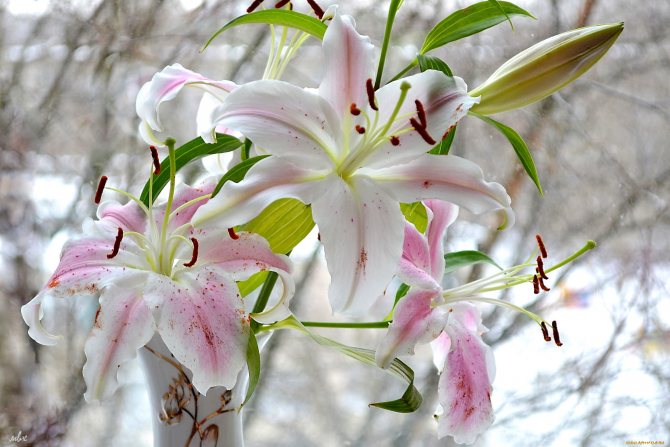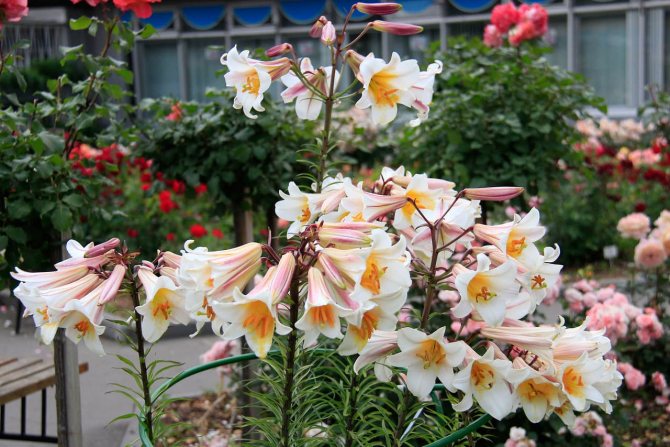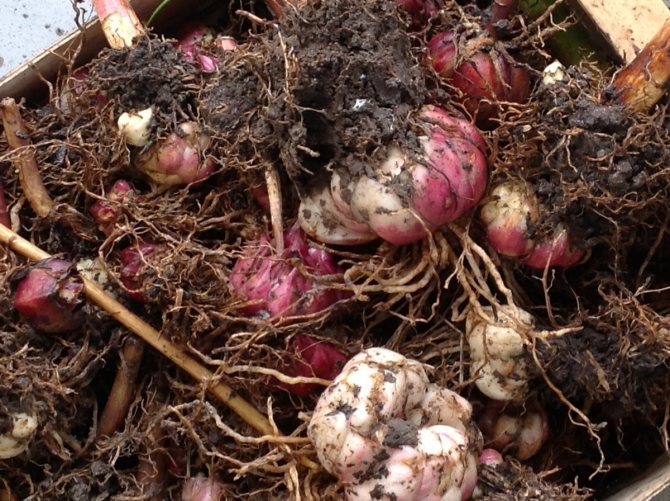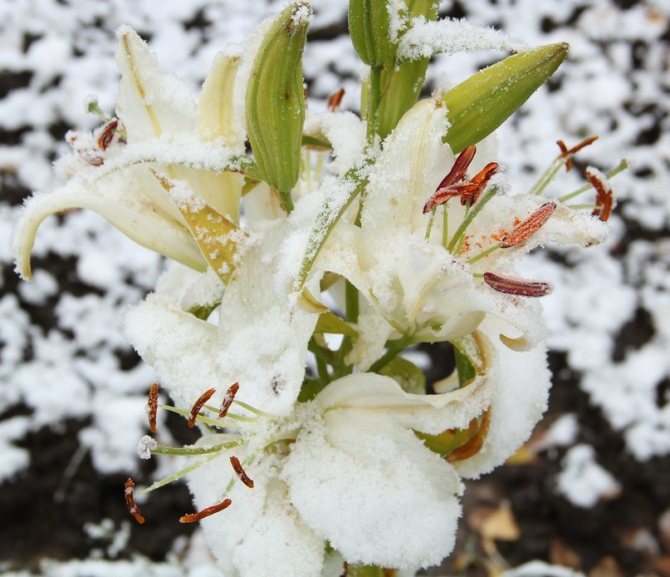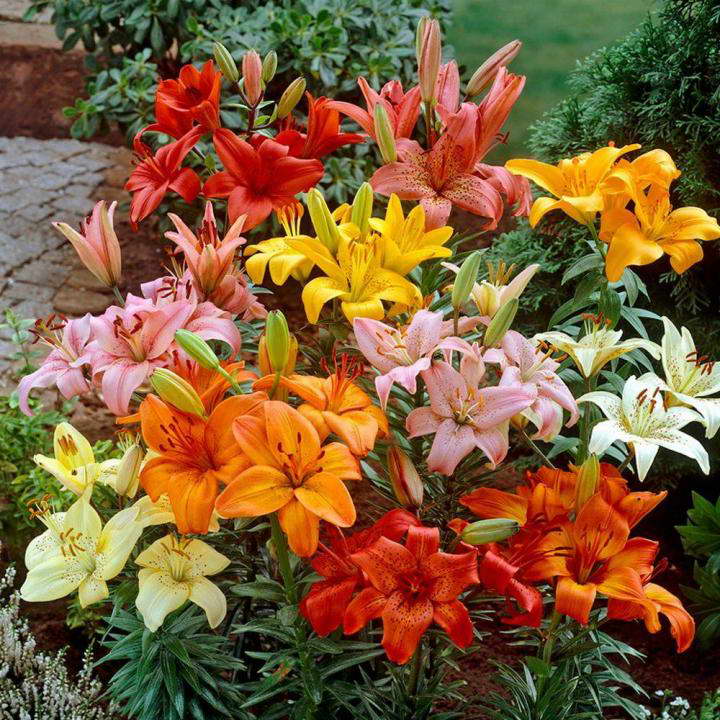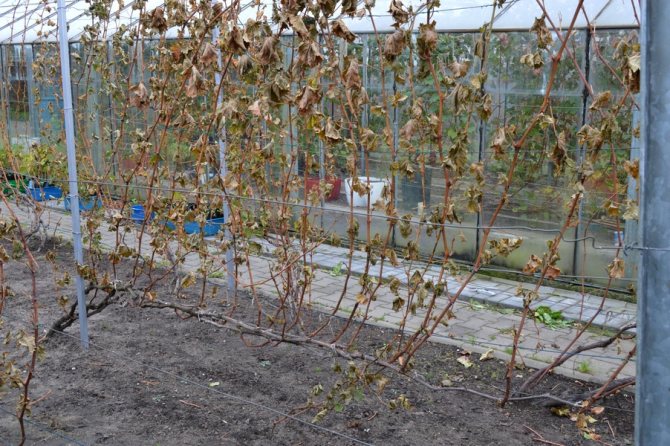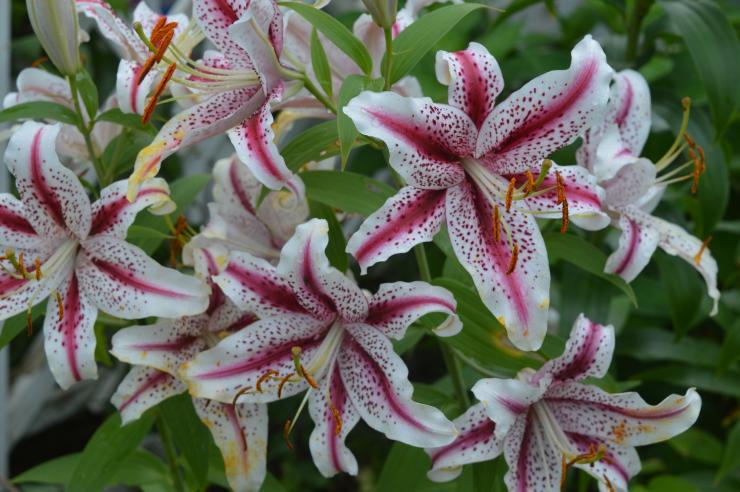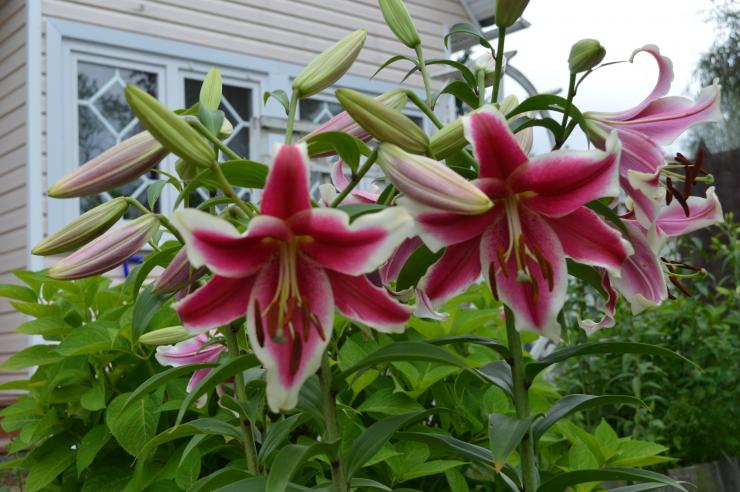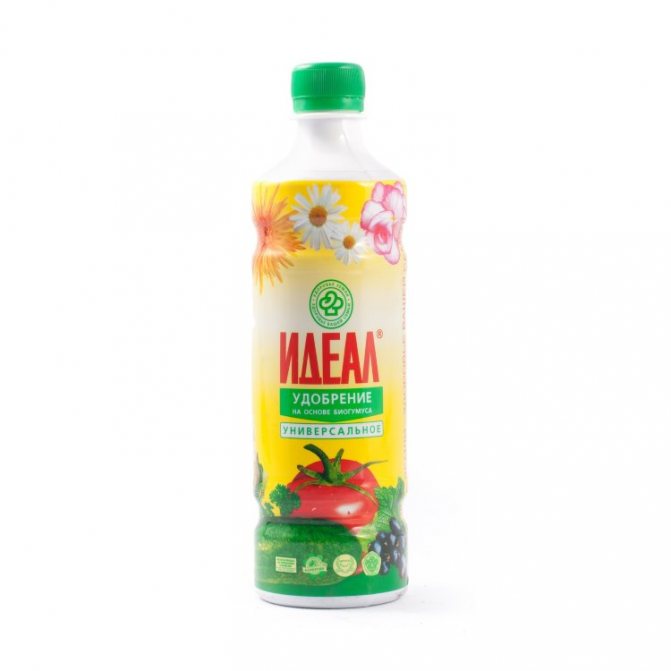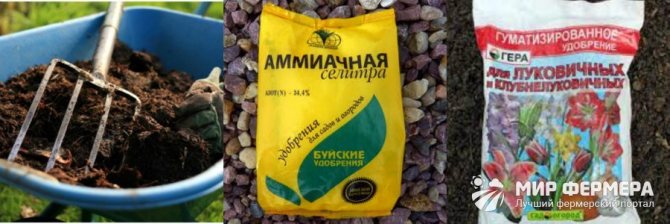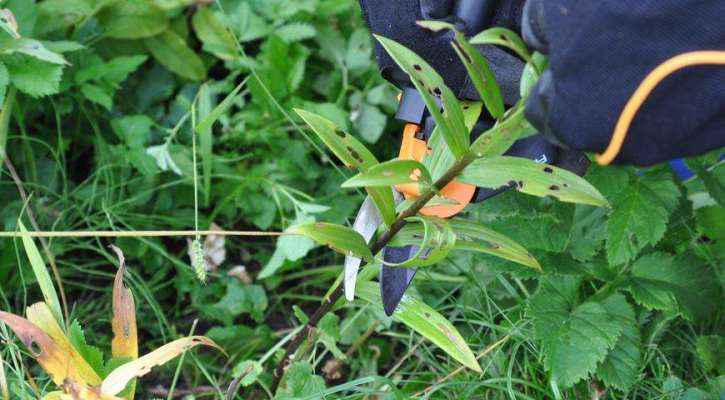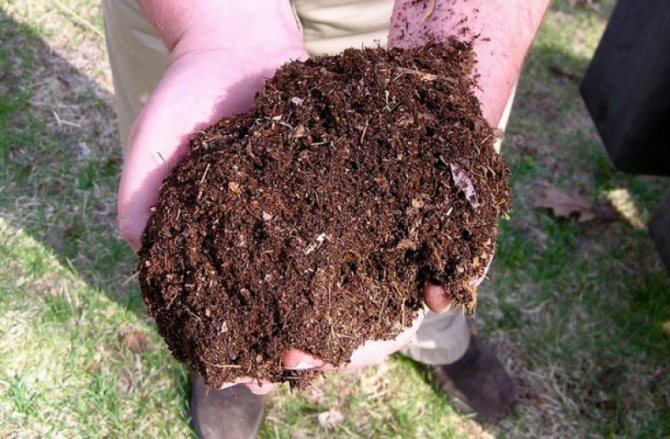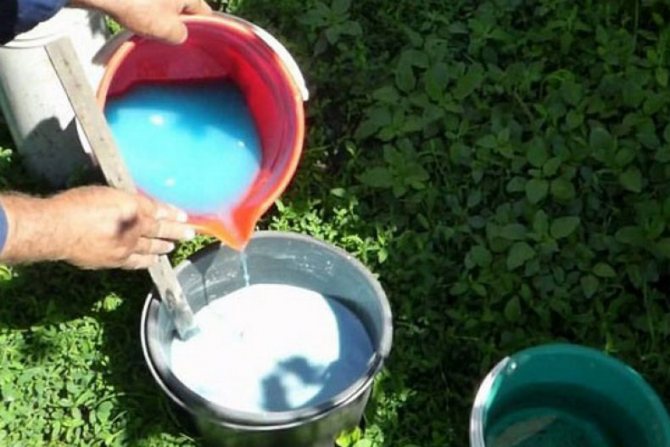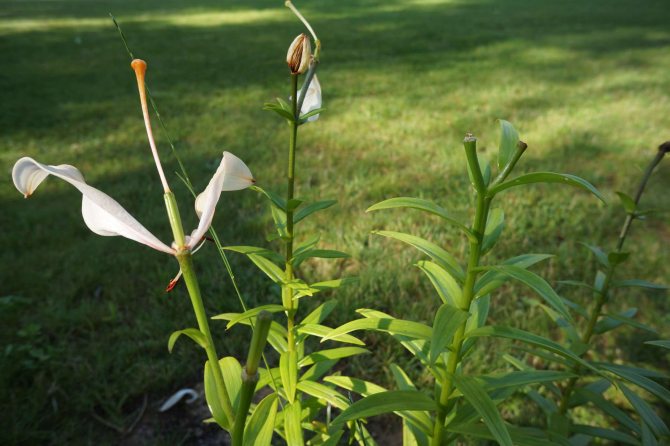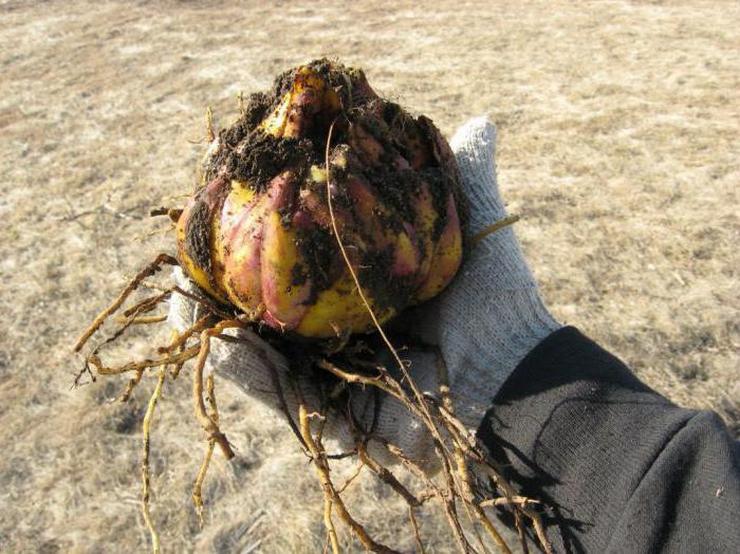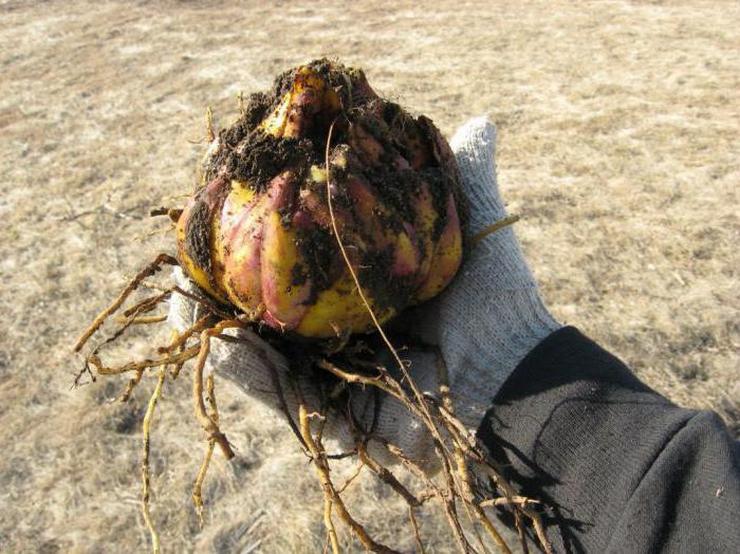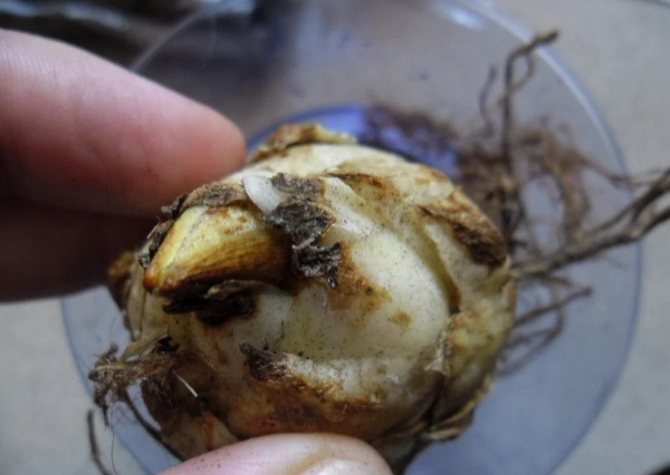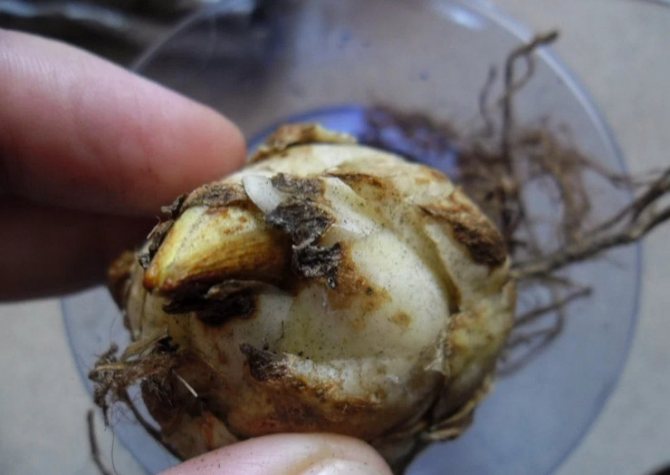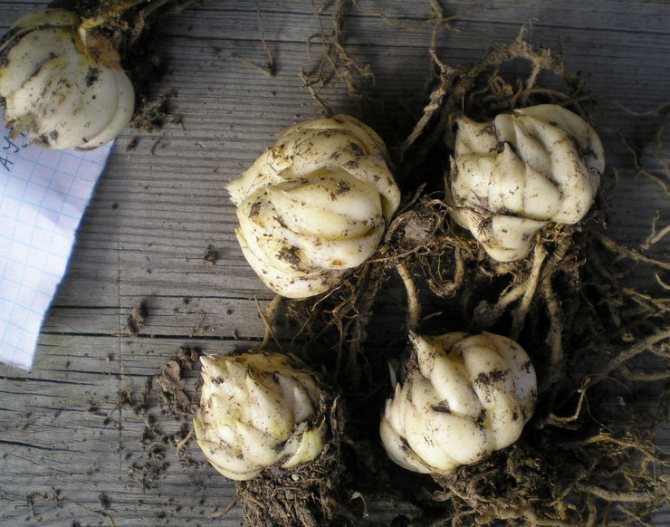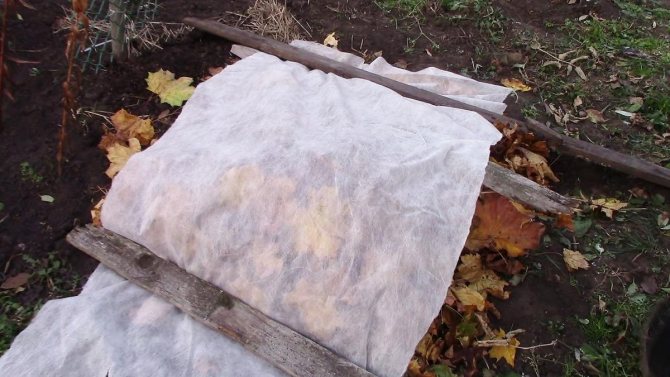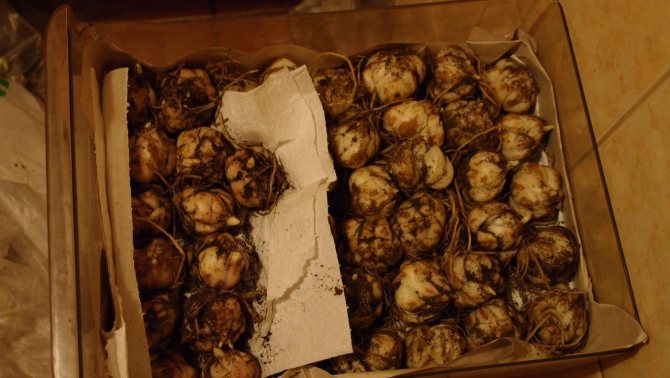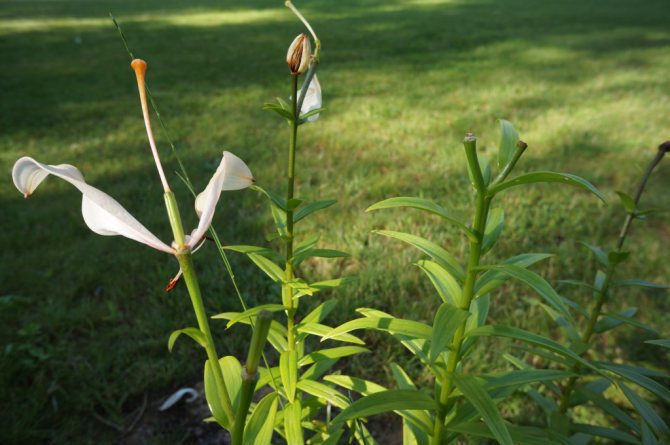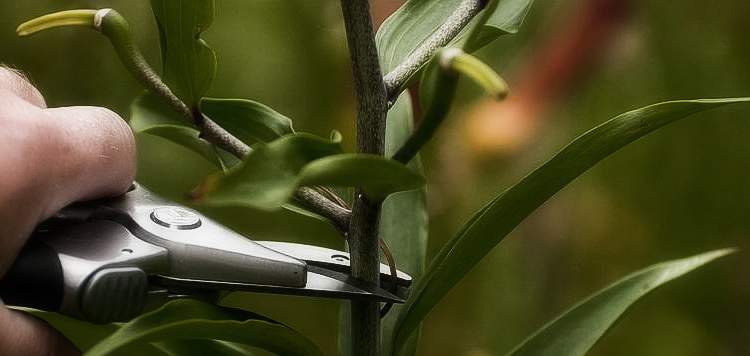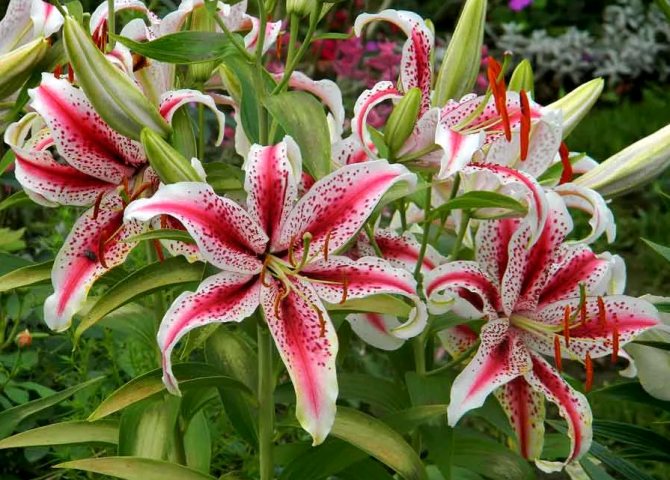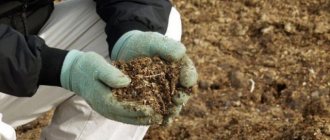During the summer season, lilies do not require much maintenance. It is enough to irrigate so that the soil around them is not dry, loosen the soil around each bush, remove weeds and apply fertilizers several times per season. But with the arrival of autumn, caring for lilies will be more difficult. How to properly prepare flowers for the winter season? When do they need to be dug up, and which of them can be simply cut and covered before the onset of cold weather? All this should be reminded to those growers who decide to grow these beautiful flowers in their garden.
How to feed lilies when transplanting in autumn and spring
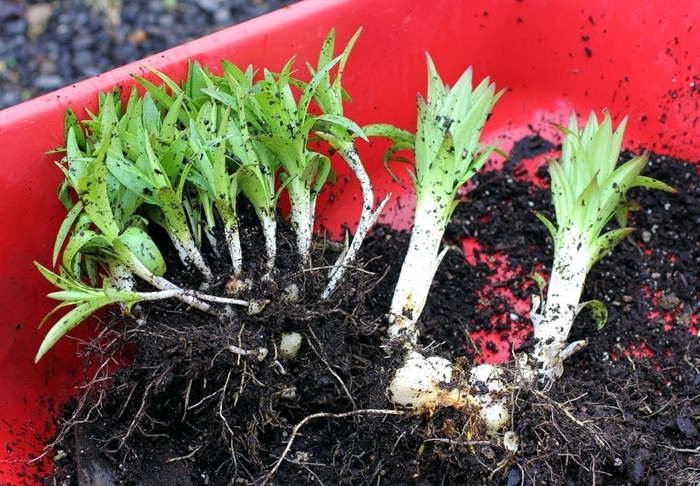
How to feed lilies when transplanting in autumn and spring
Provided that it is planted in a rested, humus, fertile soil, there is no need to apply additional fertilizing when planting. If the soil is depleted, be sure to feed it. The choice of the type of fertilizer (organic or mineral can be used) depends on the preferences or capabilities of the gardener.
Organic fertilizers have a very beneficial effect on the condition of lilies. An exception is fresh manure - it can burn the bulbs, it also contains pathogenic bacteria and insect pests.
- Use matured compost or humus, do not regret about 7-8 kg for 1 m² of land.
- You can add double superphosphate at the same time - 100 g per 1 m² of area.
- If there is wood ash, add it too, you will also need 100 g per 1 m². Thanks to wood ash, the flowers will be large, rich in color, winter hardiness and resistance of the culture to diseases will increase.
- Ash can be replaced with potassium sulfate (in the fall, potassium chloride can also be used): add 2 tablespoons of any of the mentioned preparations per 1 m² of the plot.
If there is no organic matter, you can safely apply mineral fertilizers that necessarily contain nitrogen (when planting in spring, when planting in autumn, nitrogen is excluded), potassium and phosphorus. Mineral fertilizers are varied, you can use any universal composition that you have in stock. For dosage, follow the manufacturer's recommendations.
When planting in spring, it is good to use a nitroammophoska: consume 3 tablespoons per 1 m² of area.
Autumn feeding
In September, active preparation for winter begins on all land plots. But if the soil without the presence of the main crops is easier to prepare, then perennial plants, especially flowers, require accuracy.
Rules and special instructions
Closer to September, the bulbs begin to prepare for wintering. In other words, they pass from the phase of active growth and development to the stage of rest. Nitrogen and potassium substances will help ensure restful sleep. Potassium sulfate and superphosphate are added immediately after flowering.
The best protection for oriental lilies, as well as water lilies in heavy rain, will be spraying with Bordeaux liquid. Such an autumn procedure additionally becomes the prevention of diseases.
To enrich the soil, protect against frost, they use mulch from rotted compost or leaf humus.
To make the lilies feel protected in winter, they follow the rules:
- The main manipulations should take place after flowering. Exceptionally complex mixtures are introduced in a warm form. The calculation of the standard diluted substance (5 liters of water + superphosphate, potassium salt, 1 tsp each) runs by one. One lily takes half a liter of solution.
- In the fall, potassium and phosphorus will be the best helpers for a grower in care.
- The procedures are planned in early September. Otherwise, lilies give young shoots.
- It is forbidden to add nitrogen in the autumn.
How to feed lilies in spring
Top dressing in March-April
In order to gain sufficient green mass for successful flowering, lilies in the spring, like all plants, need nitrogen feeding.
Carry out the first feeding in early spring, even on melting snow. Take urea or ammonium nitrate, spend 1 tablespoon of this or that preparation per 1 m², distribute dry fertilizer evenly over the soil surface.
If the site is on a slope, it is not effective to carry out such top dressing - most of it will be carried away by melt water. In this case, wait until the snow melts and the soil dries out a little. Feed with fertilizer in the form of a solution:
- Urea or ammonium nitrate is suitable - 1 tablespoon per 10 liters of water, consumption - 1 m² of the plot.
- You can dilute the mullein infusion in a ratio of 1 to 10 and water the plants.
How to feed lilies in May and June
In May-June, there is an active formation of buds, and in order to enhance this process, use fertilizing with complex fertilizer.
For flowering to be long, and the flowers themselves are large with bright petals, a triad will be required: nitrogen-potassium-phosphorus fertilizer.
- Nitroammophoska is perfect - dilute 2-3 tablespoons of water for 10 liters of water and pour over the lilies.
- You can use potassium humate - 50 ml of a liquid preparation per 10 liters of water.
Do I need feeding
A flower in an open field, as well as in a closed one, feels great and makes it possible to regularly enjoy the appearance of interesting buds. In the private sector, not all farmers pay attention to the flower, but most often they choose the most undemanding species.
After all, there are more than 50 varieties. But even the most common, with a long absence of feeding, die or lose their appearance.
It will not be difficult to choose fertilizers for lilies if you know the timing of application. This is the spring period. Getting the right amount of nutrients before flowering, the plant:
- more actively resists diseases, infections;
- able to resist pests;
- grows and develops better;
- increases the flowering period;
- accumulates 2 times more useful microelements.
It is necessary to feed lilies not only when planting seedlings (bulbs) in the ground. Organic and mineral substances are necessary for a flower throughout its life.
Therefore, the application schedule is designed in such a way that the fertilizer:
- in spring: promoted the development of the root system and provided the soil for the formation of buds;
- in summer to replenish elements due to budding and during flowering;
- in the fall. For strengthening after flowering.
Also, additional application of fertilizer mixtures is required if the flower had to be transplanted or health problems have arisen (the appearance of yellowness, black spots, foliage curling, etc.).
Important! A transplant after the treatment of any infectious diseases is mandatory. In this case, the soil in the pot changes completely. The earthen mixture is made on its own or bought in a store. This additional exercise helps you recover and recover faster.
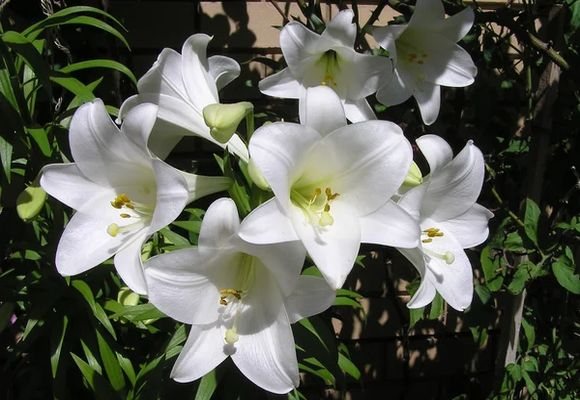

How to feed lilies during flowering
Do I need to feed lilies and what fertilizers
To prolong the excellent flowering time, an accompanying feeding is necessary. At this time, feed the plants with a full set of trace elements, i.e.use any complex mineral fertilizer: nitroammofoska, potassium humate, drugs "Stimul", Agricole (Agrecol), etc. Dilute in water according to the instructions on the package.
It is not superfluous to accompany each summer top dressing with the addition of wood ash - take a glass of ash for 1 m² of the plot, scatter it over the soil surface and carefully embed it shallowly into the soil.
When to dig out non-winter-hardy varieties of lilies?
They start digging the bulbs after the first frost.
In the middle lane, the Moscow region, the right time is mid-October. In the Leningrad region, lilies are removed from the ground a week - ten days earlier.
In the Urals and Siberia, the soil temperature drops to critical levels for flowers in mid-September. You cannot be late for harvesting the bulbs.
In the southern regions of Russia, the climate allows you to leave even heat-loving varieties of lilies in the ground.
Observing the weather in a particular area will help to determine the exact time for digging heat-loving varieties of lilies. Within the same region, the temperature difference can reach 10 degrees, which must be taken into account in gardening work.
Fertilizing lilies in summer
Summer is the time of mass flowering of ornamental plants. Therefore, it is so important during this period to support their strength with nutrients. In addition, summer dressing increases the resistance of plants to various diseases.
Features of the
The most common summer treatment is carried out using wood ash. Provided it is applied correctly and regularly, crops will delight you with abundant, bright and long flowering, while remaining healthy (Figure 3).


Figure 3. Fertilization in summer
At the stage of bud formation, fertilizing is carried out with ammonium nitrate and the vegetative parts of the plant are treated with a special solution from all kinds of pests. In the middle of summer, it is recommended to add superphosphate with potassium magnesium to the soil, which strengthen the plant stems and give the flowers brighter shades.
You should know that during flowering it is more rational to use liquid fertilizers, since granular fertilizers dissolve for a very long time, and therefore do not have the desired effect. Top dressing with liquid fertilizers occurs after abundant watering.
You can find more information on summer fertilization in the video.
rules
To achieve abundant and long flowering, it is necessary to provide the plant with various nutrients.
Top dressing is carried out in accordance with certain rules:
- At the stage of bud formation, phosphorus-nitrogen fertilizers are introduced into the soil in the form of nitrophos or azophos (1 tablespoon of the substance per bucket of water).
- In the flowering phase, it is recommended to use complex additives containing nitrogen. Therefore, you can use Azophos, Amofos or Nitroammophos at the rate of 1.5 tbsp. on a bucket of water.
- Together with complex preparations, wood ash is also added, which contributes to lush flowering. At the same time, the dosage is observed: 100 g of ash per 1 sq. soil.
Having decided how to fertilize plants in spring and summer, you should prepare in advance for autumn in order to properly feed and help the plants prepare for winter.
General rules for fertilization
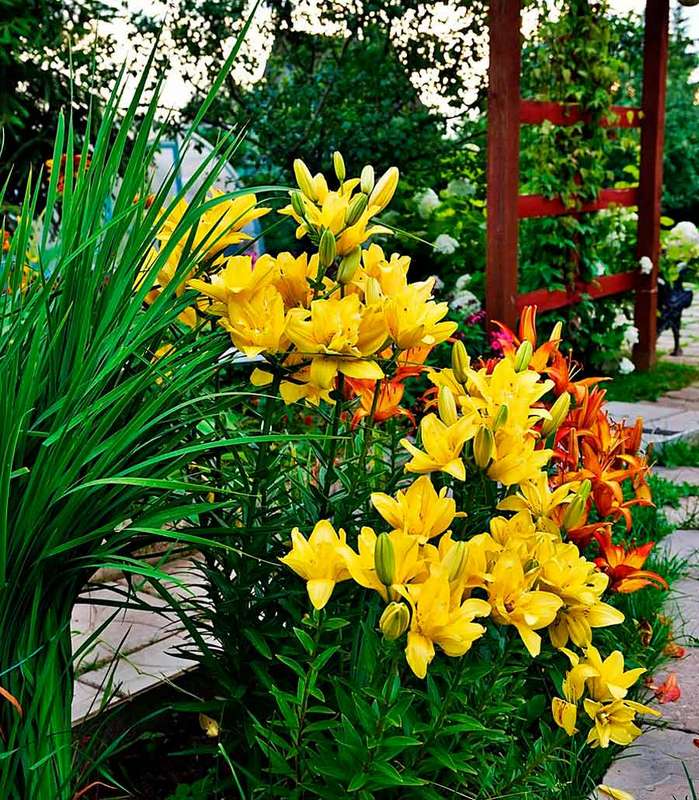

Fertilizing lilies are required throughout the spring-summer period.
There are many different varieties of lilies and they all need to be fed equally throughout the spring and summer. These perennials take any fertilizers well, but specific fertilizing should be used at certain periods of plant development. It should be borne in mind that after adding dry granular products, you need to water the lilies abundantly, since the granules dissolve poorly with a lack of moisture. Liquid fertilizers are absorbed quickly enough, but large quantities can lead to burns.For this reason, the dosage recommended on the packaging should be reduced by one third.
Lilies planted in fertile soil can be fed only 2 years after planting in open ground.
It should be borne in mind that an excess of nutrients for lilies is just as harmful as a lack of them. If you overfeed the plant, then the bulbs will begin to actively grow, and the flowering will be poor and short-lived.
Time of work
When is it necessary to feed lilies in the fall? This should be done at the end of summer, at the very beginning of autumn. It is best to feed flowering plants in dosage, but quite often. You can use potassium nitrate, using it at 30 g / m2. In the absence of this fertilizer, ammonium nitrate (25 g / m2) with potassium sulfate (15 g / m2) or potassium magnesium (30 g / m2) can be used.
If fertilization is carried out for the first time on August 30-31, then re-feeding should take place in 2 weeks, that is, on September 14-15. Strictly. Do not change the dosage!
Note! Snow-white lilies and tubular flowering hybrids, many other species growing on slightly alkaline, neutral soils feed exclusively calcium nitrate in proportions (40-50 g / m2).
This can also be done for the first time at the end of August, two subsequent dressings with an interval of 14 and 15 days are carried out in the middle and end of September, at the beginning of October with the same fertilizers consisting of potassium and phosphates. The second feeding can be done dry.
Experienced florist recommendations
If complex fertilizers are introduced into the soil, then in the first year the lilies need not be fed. But since lilies grow in one place for 4 years, then we feed the old plantings after watering or rain. from that moment on. how they will grow 10-15cm. Because this is a sign that the soil has warmed up enough for the scent to assimilate fertilizers (in cold soil (below 6–8 g), top dressing is useless). 1 type of feeding - a solution of calcium nitrate (sprouts 10-15 cm), repeat 2 times with an interval of 10 days (three times in total) 2 type of feeding Kemir, preferably with a solution. You can start dissolving the usual kemira a day before feeding. Kemira lux dissolves well, but it is expensive. To feed, too, once every 10 -14 days before the start of mass flowering, the third type of dressing before the very beginning of flowering, during budding - feed with potassium magnesium, it is believed that magnesium gives brightness to flowers. After flowering superphosphate dissolved in hot water. pouring superphosphate is useless, until the end of the growing season the lilies will not have time to assimilate it or some kind of fertilizer where there is a lot of potassium and phosphorus. like Kemir - autumn.
fanat
Lilies are very fond of wood ash, from it the bulbs are large and healthy, so I recommend adding it several times per season. As soon as the sprouts of lilies appear - the soil around them, pour the Bordeaux mixture. After the buds appear, we will feed with ammonium nitrate. The last time in the season, we feed in July (no later!). We bring superphosphate under the flowers (a tablespoon of double or two ordinary ones per ten liters of water) and potassium magnesium (one and a half tablespoons per ten liters).
Elena Pugacheva
I feed lilies with Ideal fertilizer. And it's just good manure. Horse, cow ... It is even better if it is in the form of humus (that is, if the year just lay, preferably under the film).
Aksinya
How to feed lilies during budding
During the budding period, lilies are fed with phosphorus-potassium fertilizers. They affect the number and size of buds, the brightness of the flowers and the duration of flowering. Nitroammofoska (Azofoska), or any other complex fertilizer is perfect.
It is advisable to introduce this top dressing in liquid form for better digestibility and quick impact. Nitroammofosk is diluted with water in a ratio of 1 tbsp. on the bucket.This volume is designed for watering 1 m².
Flowers respond well to foliar feeding. The main thing is to adhere to the dosage and administration rules indicated on the package.
There are many dressings designed to fertilize bulbous flowers. They are a source of balanced and well-chosen elements that plants need during different growing seasons. It is important to choose the right ones that are intended for feeding lilies during the budding period.
How to prepare lilies for winter
Preparation for winter depends on the type of lily. Each of them requires appropriate measures in order to successfully winter and please us in the next season with abundant flowering of large bells. Some species are more frost-resistant, while others do not tolerate subzero temperatures poorly - this is the reason for the difference in their wintering.
Wintering in the ground
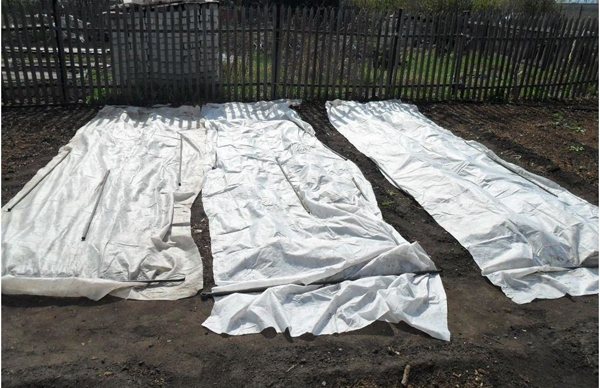

Some of the varieties of this culture need to dig out the bulbs for the winter, the rest can be left in the ground. The following lilies can hibernate right on the flower bed:
- Asian;
- Martagon;
- Royal;
- Daurskys.
In a mild and temperate continental climate, these species winter excellently without shelter. Growing them in cold regions requires the use of mulch and covering material.
How to cover lilies for the winter: video
Digging for the winter
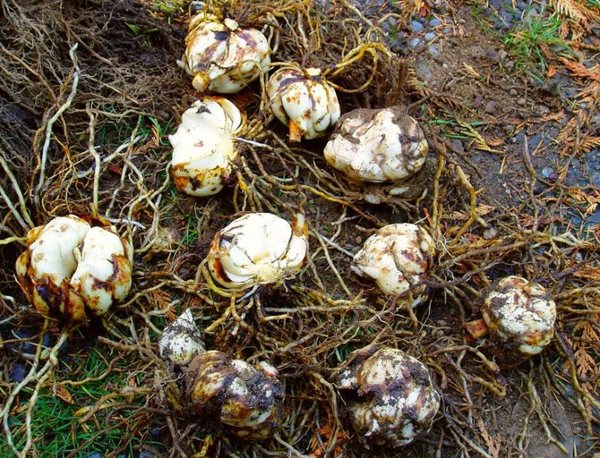

Experts recommend that you definitely dig up for the winter and store varieties of frost-resistant hybrids at home. They can freeze out even with sufficient insulation. If possible, the grower can transplant them into a heated greenhouse. Lilies that require digging for the winter include:
- American;
- tubular;
- oriental hybrids.
It is also necessary to dig out some frost-resistant varieties that give a large number of children. After that, the mother tubers are again planted in the flowerbed, and the young onions are stored at home until spring. Before digging, the stems are trimmed and the soil moistened. The bulbs are gently pry off with a pitchfork from below and taken out of the ground, then they are shaken off the soil, washed, inspected, disinfected and stored.
Before planting, the material is stored in a container filled with sand, sawdust or wet moss at a low air temperature.
Florist tips
Tips from experienced summer residents for growing and caring for lilies
Shelter for the winter
A natural cover of the beds of snow with a layer of 10 cm or more is enough. Also, as a winter fur coat for flowering plants, you can use a 10 cm layer of humus or dry sawdust.
Is the winter with little snow? Then you need to insure yourself by increasing the artificial shelter of plants (with sawdust or humus) to 15 cm. This is enough for the plants to overwinter and not freeze in the cold season.
Dry wintering
Flowering plants also perfectly tolerate dry wintering. This applies to the tubular and oriental varieties of lilies. To ensure dry wintering, the bed is covered with a waterproof material. It is better to use special agrofibre for these purposes. It will allow you to warm the garden bed, provide high-quality air exchange, and prevent waterlogging.
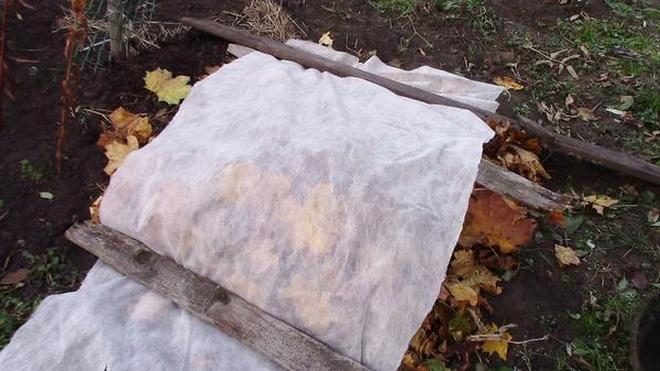

You should be aware of this! The garden bed must be dry in front of the intended shelter. You will have to scatter rodent poison around so that the pests do not destroy the bulbs.
The shelter in the spring must be removed on time. If agrofibre is removed from the garden early, the bulbs will quickly sprout, and will die during the first frost. If you are late with "exposing the garden", the plants will develop poorly due to lack of light.
Pruning after flowering
There is no need to do this. Moreover, in no case should you cut the plant at the root. This deprives lilies of the opportunity to grow bulbs for winter, accumulate nutrients for the next season.
In mid-September, the stems as well as the leaves of the plant will die off naturally.The gardener only needs to prune dried autumn flowers at a height of 15 cm from the ground, but not below.
Digging up lily bulbs and storing them in winter
But if exclusive varieties of these flowers were planted in the flower garden, the frost resistance of which the growers know little about, then it is better to dig up such lilies for the winter and store at home. There are types and varieties of these flowers that are too delicate and, even with good insulation, can freeze over the winter:
- American;
- Long-flowered;
- Oriental hybrids.
If possible, then such varieties of lilies are transplanted into a greenhouse for the winter or grown there all year round... Otherwise, the bulbs of these varieties are dug up in the fall and stored indoors.
But not only those varieties of lilies that are not distinguished by high frost resistance are dug for the winter. Some hybrid varieties from Asian and other species dug in the fall to separate the kidsgrown over the summer season from mother bulbs. During the winter, the babies grow so tightly to the main bulb that it will no longer be possible to separate them. In the spring, they will take on the bulk of the nutrients and moisture, which will negatively affect the development of the mother bulb and the entire plant as a whole. As a result, the plant will be weakened, will grow more slowly, and the flowering will be weak.
Therefore, in the fall, such lilies are also dug up, the bulbs are separated from the children, and then the main bulbs are again planted in the open ground. It is better to plant children in a flower garden in the spring, and leave them indoors for the winter.


The process of digging out lily bulbs is done in stages:
- first, the stems of the bulbs are cut;
- then you need to dig out the bulbs from the pre-moistened soil;
- all soil from them must be gently shaken off;
- you should carefully examine the bulbs - are the roots rotten, are there any dried scales;
- then they are washed under running cold water;
- clean bulbs are placed for half an hour in a disinfectant solution (in potassium permanganate or "Karbofos", "Maxim");
- then the bulbs are laid out to dry.
And only after carrying out all the above procedures, the lily bulbs are ready for storage.
How and where to store
It is optimal to store lily bulbs in cool and sufficiently humid rooms at a positive temperature of up to 10 degrees (ideally 6-8), humidity - from 70% and above.
As for the storage method, it is good to sprinkle the bulbs with a mixture of peat and sawdust (conifers) in a box that was previously covered with newspapers, and then again close the top with newspapers or paper.
Advice! During storage, periodically inspect the lily bulbs for decay and treat them with fungicides or the most ordinary brilliant green in time.
Video: preparing oriental lilies for winter - digging and storing
Fertilizer composition for lilies
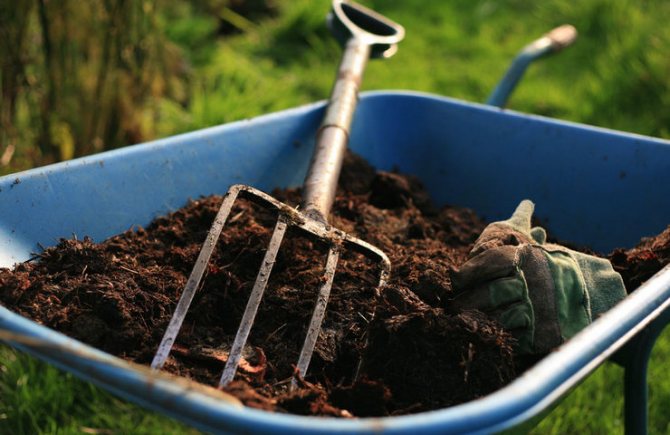

For the full growth and development of lilies throughout the summer period, the following options for spring feeding are recommended:
- 1 tbsp ammonium nitrate for every square meter of a flower plot;
- Complex fertilizer - nitroammofoska;
- For 10 liters of water - 1 liter of fermented mullein solution;
- For 10 liters of water - 1 glass of wood ash, pre-sifted (used periodically in small volumes throughout the spring season or once together with irrigation water);
- Compost humus or rotted manure;
- Biohumus obtained as a result of the activity and life processes of earthworms;
Experienced florists and gardeners do not recommend using fresh manure or mullein as fertilizer for lilies. Such feeding contributes to the appearance of various infectious or fungal diseases. In addition, the aggressive microflora of this fertilizer can cause rapid rotting of the bulbs and the death of the entire plant even before the beginning of the flowering period.
Table: Signs of Nutrient Deficiency
| Name of substance | The main signs of a deficiency |
| Nitrogen | Leaf plates turn pale green, and some leaves turn yellow |
| Potassium | In plants, there is a delay in the growth and development of buds |
| Phosphorus | The plant lags behind in development, and its leaves turn pale and dry out |
| Magnesium | The leaves turn pale, and the edges and tips of the leaf plates gradually bend |
| Calcium | Sheet plates are deformed and fall off |
Top dressing and fertilizers
In late autumn, potash-phosphorus fertilizer can be applied as a top dressing. It can be the Kemira Autumn complex or the Autumn fertilizer. In the absence of extra material resources, the gardener can independently prepare fertilizer by dissolving about (5-6 liters) in one bucket of water:
- 2 tablespoons of potassium magnesium;
- one spoonful of superphosphate.
In order for the nutrients to quickly dissolve in a bucket of water, it is best to preheat the water to room temperature. The garden should be watered as follows: one bucket of water per 1 square meter of soil.
Some gardeners use wood ash left after heating a country stove as fertilizer. Do you need it? Is it safe? Yes, it is necessary and safe!
Useful Tips


Growing luxurious lilies on the site begins with the right choice of planting material. The bulb should be evenly colored, with dense scales, without spots or damage.
Also pay attention to the following points:
- When placed on a flower bed, it is required to take into account the varietal variety of lilies. A tubular Asian and Oriental hybrid needs an abundance of sun. Curly lilies do well in partial shade.
- It will be great if the site for the flower bed is located on a hill, this culture does not tolerate stagnant water.
- Large-flowered lilies are best used for single planting, and small-flowered varieties are planted in groups.
- All lilies need a lot of nutrients for high-quality flowering, so regular feeding is necessary.
- It is impossible to bring weakly decomposed manure under the lilies, there is too much pathogenic microflora in it.
- Eastern lines require acidic drained soils. Asian la hybrids prefer neutral soil. The tubular variety needs a slightly alkaline soil.
- Varieties with tall, thin stems require a garter to prevent breakage.
Lily care in autumn
Lilies must be prepared for winter. Despite the fact that this plant tolerates cold well and hibernates without any problems, nevertheless, it is better to play it safe and help the flower to withstand winter frosts, which are very severe.
In addition, not all varieties of lilies are resistant to cold weather. If Asiatic lilies tolerate frosts well enough, then oriental and tubular lilies are not so persistent and can die without preparation. These types of lilies should be given special attention.
Therefore, the area of the garden where lilies grow must be prepared for winter. First, you should cut off withered stems with a sharp pruner.
You need to cut the stem not at ground level, but leaving a small piece above the soil, no higher than 15 cm, you can even a little less.
It is advisable to cut the stem at an acute angle, so you will be reinsured against getting an infection there.
Then the soil in which the bulbs will remain for the winter must be covered (mulched) with dry leaves, sawdust or humus. The thickness of the layer of such a coating should be at least a few centimeters, then the bulbs will feel great in the ground even in the most severe frosts.
If you live in areas with severe winters, where there are severe frosts, and little snow falls, it is advisable to additionally put spruce branches on the mulch layer, which will protect the lilies from freezing.
This will allow the bulbs to overwinter, and the next year will again please you with abundant flowering.In addition, the mulch will serve as an excellent spring feeding for the bulbs.
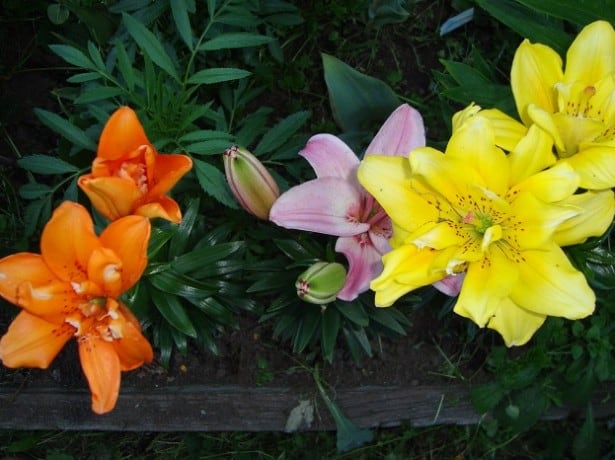

How to properly cover lilies for the winter
If flower growers leave their flowers to winter in the open field, then before the onset of cold weather, most of them should be covered. You can leave these flowers without shelter if the winters are mild in the region (for example, in the South of Russia), and the varieties are highly frost-resistant.
In principle, if lilies do not grow in the Far North (and close to them in climatic conditions), then many varieties and hybrids can be left in flower beds for the winter:
- Asian (tiger) hybrids;
- Martagon (curly);
- Candidum;
- Tubular;
- hybrids Longiflorum Asiatic (LA),
- OT hybrids;
- Royal;
- Daurskys.
All of the above varieties feel great in the garden in winter, only they should be covered in case of severe frosts.
Shelter is necessary only long-flowered, oriental and American lily hybrids.
Usually, lilies do not need special shelter.if a large amount of snow falls in the region in winter, which will cover the bulbs during the winter. If there is little snow or the winter will be warm, then care should be taken in advance to prepare a natural covering material. It is best to use needles (pine or spruce sawdust, or spruce branches), under which slugs and other "harmful" insects, as well as pests (especially mice), which can damage the growth points of bulbous plants, will not crawl. On top of the needles, you can pour a layer of high-moor peat, which will prevent the needles from scattering in gusts of wind. In colder regions, the top is covered with a special covering material.
By the way! In autumn, with heavy rains, it is recommended to lightly cover the lilies with a film. As soon as a constant minus is established, the film is removed.
Thus, lilies should be properly covered for the winter, and the shelter should be removed (removed) in time. If harvested too early, the growing stems will freeze during the spring frost. And when opened too late, the stems grow too thin.
Summer fertilizers
Experienced gardeners use ash water as a top dressing throughout the summer. It is used about 5 times in the entire season. It is thanks to this care that the flowers turn out to be larger, brighter. The flowers will grow very strong and resistant to any disease.
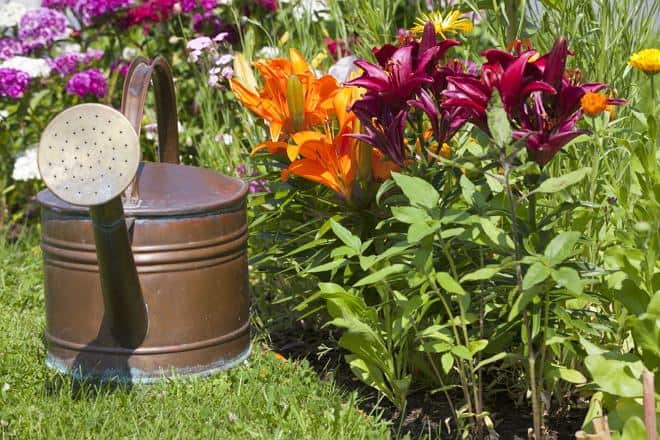

Fertilizing the soil
In the summer, when the buds will form, you need to fertilize the plants with ammonium nitrate again. All parts of the flower should be treated with the same solution. That way they will grow up healthy. In July, you again need to take care of the lilies with the help of dressings. To do this, it is necessary to apply fertilizer to the ground from two ingredients: potassium magnesium and double superphosphate. This will strengthen the stems of the flowers, and the color of the buds will be much brighter and more beautiful.
It is important to remember that the fertilizer must be liquid. A granular product will not give the desired effect, since it will not have time to dissolve in the soil in time.
When to start preparing for winter by region
Preparatory activities are carried out in the same way, but at different times, taking into account the weather conditions of a particular region. Particular attention should be paid to preparing lilies for winter in residents of cold climatic zones.
In outskirts of Moscow
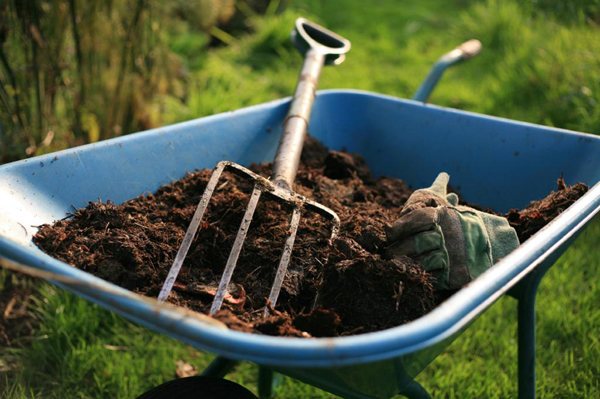

Autumn pruning of lilies in the Moscow region is carried out at the end of September. The stems are cut at ground level or leaving small stumps. Healthy aboveground parts can be used for compost, and diseased parts must be burned. Top dressing containing phosphorus and potassium is carried out in August, about 2 weeks after the end of flowering.
As a mulching layer, some gardeners use horse manure, which is spread in a thin layer over the plantings with lilies. This will need to be done in early November, when the top layer of the earth will freeze. In the spring, along with melt water, the fertilizer is absorbed into the soil and absorbed by the bulbs.This makes it easier for the gardener to take care of the flowers in spring. The next top dressing will need to be done only on the eve of flowering.
In the Urals


For growing lilies in the Urals, it is better to provide places on the south side of the building, where they will be protected from cold winds. In autumn, here, just as in the middle lane, they carry out pruning, feeding, watering lilies. If the autumn period turned out to be rainy, after pruning, it is advisable to cover the flower bed with foil so that the bulbs do not get wet from excess moisture.
On dry and sunny days, you can open the film. Those lilies that were planted shallow need winter shelter even before the start of frost. The rest of the plantings are covered when the soil is 3-4 cm frozen.La hybrids and Asiatic lilies can easily winter under the snow. Oriental hybrids and other frost-resistant varieties will need to be insulated.
In Siberia


Only adapted varieties are suitable for planting in this region. In Siberia, summers are short and winters are long and cold. Lilies can be saved in such conditions either by digging them up in the fall, or by properly insulating them. Lilies are pruned in early September.
Immediately thereafter, they are either dug out or covered with a mulch layer. Top dressing of lilies should be carried out twice - immediately after flowering and after another 2 weeks. During the September rains and the first frosts, the plantings can be covered with cardboard boxes, and when the temperature drops, dry leaves can be placed under the boxes. You can also use a peat or compost mulch as cover.
On a note! In the Siberian climate, the thickness of the shelter should be one and a half times greater than usual.
In the Leningrad region


The climate of the Leningrad region is characterized by high humidity and an abundance of rain. Here, lilies need a mandatory shelter from streams of water, otherwise the bulbs will simply rot before wintering. Oriental hybrids are especially sensitive to excess moisture. For shelter from the rains, it is convenient to use wire frames, on which a film is thrown from above.
Peat or leaf humus is used as winter insulation; in addition, you can cover the plantings on top with agrofibre. Preparation for winter is carried out with the arrival of the first frosts, which occur in the Leningrad Region in the second decade of October. Of course, the dates can be shifted due to the vagaries of the weather.
When to prune perennial flowers in the fall
Basic requirements for storing bulbs
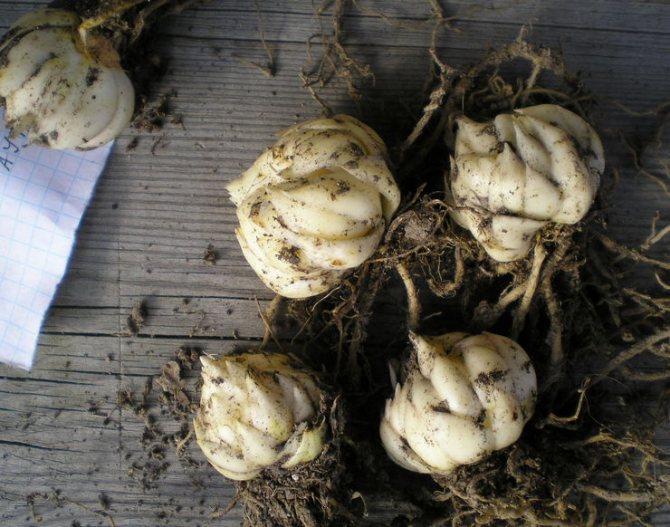

Preparation, processing and sorting of bulbs
Several preparatory procedures are recommended with the dug out bulbs for their further high-quality storage in the winter months.
First, you need to separate all daughter bulbs and rinse all planting material well. Then you need to trim the stems and roots, their length should not exceed 5 cm. Next, each bulb is examined in order to exclude the presence of a disease or the beginning of decay. Damaged and infected bulbs cannot be stored. If there is a slight damage, you can try to cut it off, and then treat it with brilliant green or sprinkle with crushed activated carbon (or wood ash).
Preventive treatment is required for all healthy bulbs prior to storage. First, they are soaked for 30 minutes in a warm disinfecting solution based on manganese or karbofos. As a prophylaxis against the appearance of an onion mite, a soap solution based on laundry soap is used for washing. After that, damp bulbs should be dipped in wood ash and left in a dark room with good air circulation to dry. It is very important not to overdry the planting material, as it will become unusable.
The next procedure is sorting. Large and medium-sized bulbs are useful for spring forcing, and the smallest bulbs can be used for planting in flower beds during the spring season.
Temperature
The most favorable conditions for proper storage of bulbs are temperatures from 0 to 5 degrees Celsius. In such a moderate cold, the bulbs will not freeze, but they will not germinate either.
Storage
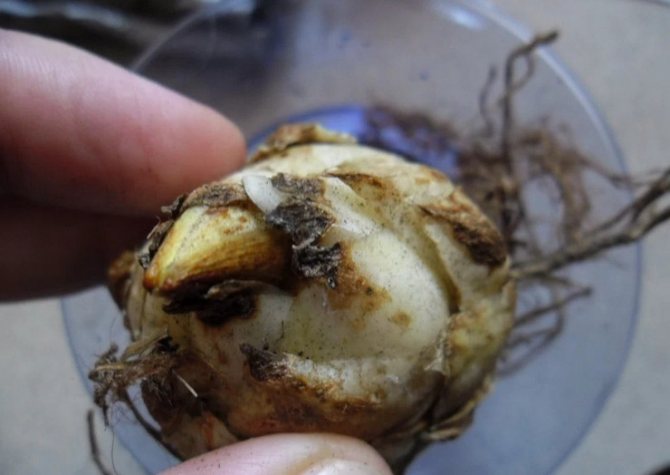

The storage site should have conditions under which the planting material will maintain the necessary humidity and receive fresh air in the form of regular ventilation. One of the most suitable storage locations is a household refrigerator or basement. It is important that the bulbs are not stored in the refrigerator with vegetables and fruits, since most of the fruits negatively affect the lilies with ethylene gas. A loggia, glazed balcony or cellar can also be a storage place, but bulbs can suffer from unexpected temperature changes.
Storage methods
Wet wintering - during wet storage, the planting material retains the necessary moisture and air permeability. You can put the bulbs in a plastic bag filled with sand or moistened peat, but it is better to put them in moss and wrap them in tissue paper. As the wrapper is moistened, it is replaced with a dry one.
Dry wintering - dry storage means placing the bulbs in dry soil with a waterproof cover. These bulbs need timely moistening (about 2 times a month) and treatment with manganese solutions at the first signs of mold.
Wintering in the open air - a place for such storage should be chosen on a site in a lowland, where snow lies for a long time, and high snowdrifts accumulate. The construction of the storage consists in preparing a shallow trench with a cover, the walls and floor of which must be insulated with polyethylene or thick cardboard (or dry peat). This material will perfectly retain moisture and heat. The bottom of the storage is covered with a reliable drainage layer, which will protect the bulbs from melted snow in spring.
Experienced flower growers recommend placing small containers of water in a prepared trench together with the bulbs in order to control the temperature inside. If the water is not frozen when inspecting the storage, then the bulbs are safe.
Potting
You can save the planting material in another way, if you transplant the plants from the garden or flower garden into an ordinary pot, and after the aboveground part wilts, rearrange them in a cool room with a temperature of 5 to 10 degrees and with good lighting. The main care is moderate soil moisture as needed. These bulbs are suitable for spring planting in open flower beds.
Disease prevention, pest control
Preventive treatments are carried out annually in spring and autumn. Pruning of plants partially solves the problem - spores of fungi, eggs and larvae that remain to winter on the stems are removed. It is also necessary to spray the "hemp" remaining from the lilies and the soil in the flowerbed with 2% copper sulfate, Bordeaux liquid or a solution of any fungicide (dosage and consumption rate are determined in the instructions).


For the treatment of lilies, you can use any fungicides - from long and well-known to gardeners of copper sulfate and Bordeaux liquid to modern preparations of biological origin
Of the pests of lilies, thrips, aphids, and a lily fly are most often attacked. Any general action insecticides - Mospilan, Spark Double Effect, Aktara will help prevent their appearance. The treatment is carried out 7-10 days after spraying with fungicides.


Aphids are distinguished by their rare "omnivorous", they attack almost any garden crops with whole colonies
Introduction
You can hear different opinions from experienced gardeners: some argue that preparation for the winter of lilies is completely unnecessary, they will winter so well and will even bloom more abundantly, others advise covering the plants with fallen leaves for the winter, and still others believe that it should definitely be from autumn dig up the lily bulbs.
The reason for such opposite opinions is that the wintering of lilies directly depends on their variety, as well as on the region in which they are grown. So, in central Russia, you can leave Asian hybrids, hybrids OA, OT, LA, Daurian lily, Pennsylvania and Martagon lily in the soil for the winter. King lilies and Candidium tolerate winter well under cover. But how to preserve the lilies belonging to the Eastern, Tubular, American hybrids, which are not adapted to the harsh Russian winter? These varieties are either planted in the ground in the summer, or even grown in greenhouses, they can overwinter only with careful shelter.
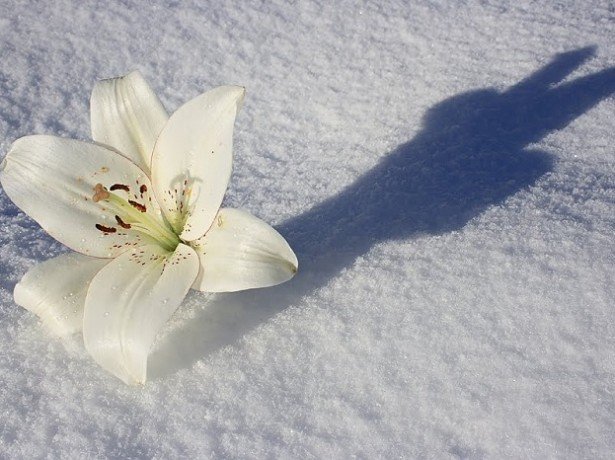

Royal lilies and candidum tolerate winter well under cover
Hybrids LA and Asiatic lilies are usually dug up for the winter for the reason that over the summer their bulbs are heavily overgrown with babies, which by spring grow tightly to the mother bulb, drawing water and nutrients from it. As a result, the lily will grow and bloom worse.
How to fertilize lilies
Experienced gardeners know when to plant lilies in their garden beds. This is best done during the off-season. In the spring, transplanting lily bulbs into open ground is done as early as possible. In autumn, the most suitable months are September and October. Bulbs with a dying stem, that is, those that have completed the growing season, should be planted.
Fertilizing lilies when planting
How to feed daylilies before and after flowering,
It is important to know how to plant lilies correctly. They do not like shady places and constantly moist, compacted soils. They should not be planted under spreading trees in the shade. Depending on the variety, they choose sunny places or partial shade.
Plants grow and develop well if there is a sufficient amount of humus in the root area. For each square meter of planting, a bucket of well-rotted compost is introduced and dug up. You can add urea in the amount of 200 g per 10 sq. meters. In order for the plants to bloom well, 500 g of potassium sulfate 1 kg of superphosphate is scattered under the digging. An alternative can be complex fertilizers: diammofosk or azofosk.
Feeding lilies before flowering
During the appearance of the first buds, lilies need mineral fertilizers with potassium and phosphorus. It is convenient to use complex formulations that are sold in specialized stores.
Note! If necessary, feeding lilies before flowering is prepared independently. In 10 liters, 1 tbsp is diluted. l. superphosphate and potassium sulfate. Fertilizers are applied by irrigation at the rate of 3-4 liters per 1 sq. m.
Fertilization features at the budding stage
At the budding stage when applying fertilizers, you should mulch the soil well with sawdust or cut grass. These measures are necessary to avoid drying out the topsoil with strong evaporation. Abundant infrequent watering is required.


Lilies in buds
How to feed lilies in June during flowering
Gardeners should know how to feed lilies in June before flowering. The rich color of the petals will help give ammophosk. It also helps plants to resist stress, disease and pests.
Feeding flowering lilies is carried out in the same way as during budding.
Important! The fertilizer must contain nitrogen. It is one of the main nutrients. Its deficiency inhibits the growth of the plant.
Usually urea or nitrophosphate is used. Plants are watered at the root, water should not fall on the leaves.
Top dressing after cutting or flowering
In the autumn, plants are preparing for winter and proper feeding is especially important for them. At the end of summer, new fertilizers are applied. These can be complex preparations containing superphosphate and potassium sulfate. They will replenish the supply of nutrients and protect against disease. Nitrogen fertilizers cannot be applied.
You should focus on the climatic conditions of the lily growing zone.Mineral fertilizers should not be applied too late, otherwise green shoots may appear. You can use mature compost or manure-based humus. The soil will be replenished with useful substances and will receive additional shelter from frost. The compost layer is located on top and is about 10 cm. In the spring it is stirred by loosening.
Top dressing in autumn
Flower bulbs in late summer and early autumn, after flowering, begin to actively grow and stock up on the basic nutrients that will be required next year. To make plants easier to endure the winter cold and regain strength after abundant flowering, in the first month of autumn they should be feed with phosphorus-potassium fertilizers
... It is advisable to use superphosphate-based fertilizers during this period, as well as potassium magnesia.
When the winter cold begins to approach, the plants are prepared for wintering. So that the lilies do not freeze, they are insulated by mulching with dry fallen leaves or a layer of humus, after cutting off the ground part. In regions with difficult weather conditions, the flower culture is additionally insulated for the winter with spruce branches.
Secrets of Successful Care
Lilies are quite unpretentious to care for, but you still need to know a few secrets before starting to grow this beautiful plant.
When caring for a lily, it is important to choose the right place to grow it. It should be such that the lower part of the stem is in the shade, so that drying out and overheating of the soil around the bulbs can be avoided. For this purpose, lilies can be planted in compositions with low to medium stature flower crops. Lilies are especially well combined:
- with bells;
- nivyaniks;
- hosts;
- daylilies.
Lily care consists in watering. During flowering, the plants are moistened moderately, and if this period coincided with a drought, then the area is watered abundantly several times so that the bulbs avoid water depletion. When the plant has faded, watering can be stopped altogether.
If lilies need to be cut for a bouquet, then a part of the stem with leaves must be left above the ground. Thanks to this, the bulbs will continue to develop fully. It is recommended to cut it obliquely so that rainwater does not get inside the stem and it does not rot. In the fall, all lily shoots are cut off, leaving a stem up to 20 cm high.
So that plants do not suffer from frost in winter, they should be covered. For this, spruce branches, agrofibre, film, sawdust and other materials are used. The main thing is that the soil and material are absolutely dry. In the spring, when the threat of frost disappears, the shelter is removed so that the undeformed shoots of lilies develop normally.
Thus, lilies are very common in garden plots. Due to the huge variety of varieties, a wide range of colors and ease of care and cultivation, you can create spectacular flower arrangements on the site. Such a flower culture must be fed, using various fertilizers at different periods. Only then will the lilies look healthy and attractive.
My beauties lilies are already two years old. After planting, I did not touch them, and the plants formed many children during this time. Now I will plant them, especially since I want to exchange varieties with my neighbor. Tell me what fertilizers can be used for planting and transplanting lilies? They are tubular hybrids.
Lilies need loose soil and additional nutrition. For abundant and beautiful flowering, it is important to create suitable conditions for them and provide a supply of necessary elements at the initial stage. This task is easy to cope with by applying fertilizer directly when planting / replanting lilies.
When to trim
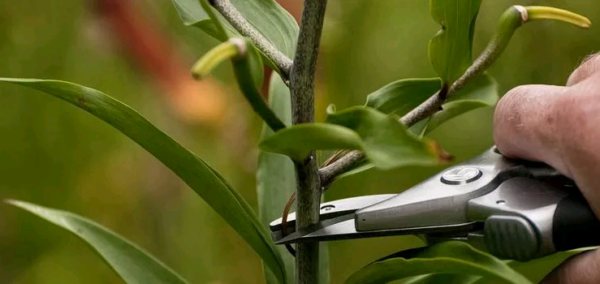

Lilies should be pruned by the time the bulb is fully ripe and ready for wintering.These times depend on the time and duration of the flowering of the plant, as well as on whether the flowers were cut or not.
Should lilies be trimmed immediately after flowering?
You cannot cut lilies immediately after they have faded, even if you really want to quickly get rid of unsightly bare stems right in the middle of the flower. The fact is that during the flowering period, the plants spend all the energy they generate exclusively on the formation of buds and the blooming of flowers. At the same time, the bulbs are depleted and deprived of all nutrients.
When the flowers have faded, the plants begin to form fruits. During this phase, lilies also spend all their energy on ripening the seeds. If you do not need them, then the tops of the shoots should be cut off (only to the base of the inflorescence, leaving the stem intact). Then the generated energy will not be wasted: it will be used to prepare the bulbs for wintering. They will stock up on nutrients that require photosynthesis to be produced. And with cut off shoots and leaves, lilies will not be able to photosynthesize, which means they will not be able to prepare for winter either.
When to prune after flowering
In order for the lilies to have time to prepare the bulbs for wintering, they need at least 3-4 weeks. Since they begin to stock up on nutrients and ripen after the end of flowering, it is quite simple to calculate the period when they can be cut off: count 21-28 days after the last petals have fallen off. For example, if a lily faded on August 15, then you can cut its stems on September 5-12.
Important! If you do not remember when your lilies faded, then follow the following rule: pruning the stems should be done when they turned yellow and began to dry out. This means that they cannot bring any benefit to flowers.
Fertilizing lilies when planting
If the soil in which the bulbs are to be planted is rested, fertile, humus, then the pre-planting fertilizer can be omitted. In other cases, the soil will have to be fertilized. Which fertilizer to choose depends on the preferences of the owner of the garden.
Lilies love organic matter (the exception is fresh manure, which should never be applied). The rate of application of organic fertilizers is standard: 7-8 kg of humus or matured compost per 1 sq. M. At the same time, you can add double superphosphate (100 g per 1 sq. M). If there is wood ash, this is a great success, since lilies adore it, responding to the addition of ash to the ground with large and bright flowers, increasing winter hardiness and disease resistance. Wood ash is added at the rate of 100 g per 1 sq. M.
If there is no organic matter, then any mineral fertilizers are applied, including nitrogen, phosphorus and potassium (for spring planting) and phosphorus and potassium (for autumn planting). There are many types of mineral fertilizers. Depending on which of them were at hand, they can be added in the dosage indicated on the package.
Feeding lilies can be combined with watering
Transplant scheme
The transplant is carried out in spring or autumn, but most growers usually combine the transplant with digging out the bulbs, because at this time the bulbs are dormant and tolerate the procedure well.
The frequency of transplants is determined by climatic conditions and flowering characteristics of a particular variety, for example:
- Oriental and Orleans lilies require annual transplantation;
- slow-growing and hybrid plant varieties are transplanted every 5 years;
- American hybrids can be transplanted every 10 years.
If perennials are not transplanted, their flowers become smaller, and the plants themselves lose their immunity and are often exposed to various diseases. The step-by-step instructions for performing a transplant are as follows:
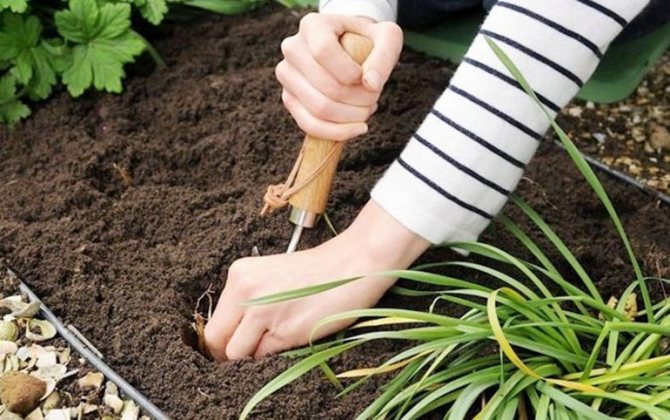

- Choose an area that is sufficiently illuminated by sunlight, protected from drafts and strong winds. Flowers should not be planted in places where groundwater rises.
- Dry stems are cut at the root, then the peduncle is carefully dug out with a pitchfork (they do this so as not to damage the planting material) at a distance of 30 cm from the stem.
- The bulb is freed from excess soil and cleaned of dead scales.
- The peduncle is cut off, leaving a process of no more than 10 cm.
- Children are separated from the mother's onion.
- For disinfection, the onions are dipped in a strong solution of potassium permanganate for 1.5 hours, then the children are dried and treated with charcoal.
- They are planted in a permanent place (flower bed, flower garden, mixborder, etc.) at a distance of 15-20 cm from each other.
- Cover with a layer of peat or fallen leaves.
It is no longer necessary to take care of the bulbs until the arrival of spring.
Why fertilizing lilies is important
How to feed phlox in June before flowering
The bulb is the underground part of the plant. Full growth, the formation of lily buds will depend on its development. It is important to know what and how to fertilize lilies. Timely and high-quality feeding will help you get healthy green mass and beautiful flowering next year.
What can not be fed lilies
Lilies should not be fed with fresh manure. Plants can become sick with fungus and wither away.
The best time to fertilize
Lilies are fertilized depending on the climatic zone. You should focus on the temperature of the soil. The first top dressing is carried out when the soil warms up to + 6-7 ° C. It could be early April—May. Top dressing is also carried out, focusing on the height of the stem, it should be at least 10 cm.
Lily hiding methods
If you have already decided that it is not worth digging the bulb for the winter, it grows in an elevated area and is protected from wind and groundwater, you should still worry about shelter.
For this, various materials are used, both natural and artificial. On a lily, you can lay out sawdust, humus in a thick layer of 15-20 cm or build spruce branches, that is, cover with spruce or pine branches.
Roofing material, film or roofing felt can be used as a shelter. Whatever material you choose, it will reliably protect flowers from frost and heavy rainfall. They remove the shelter when the weather conditions return to normal and the temperature is above 0 ° C.
Autumn care for lilies, although it seems troublesome at first glance, actually does not require a lot of your efforts and work. Having done the above procedures before winter, you will be sure that in the next season your flowers will only be more beautiful.
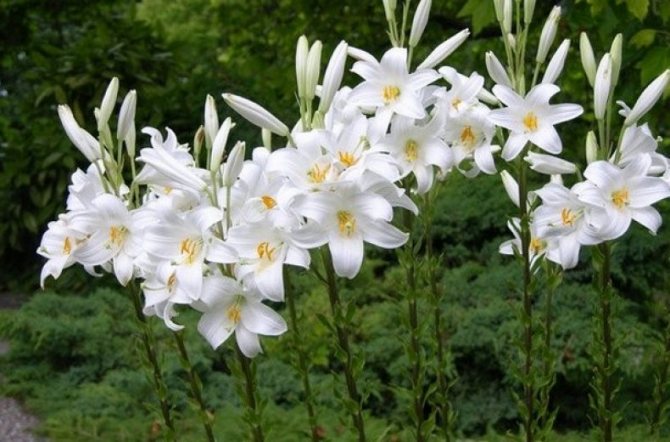

Bulb digging procedure
Lilies do not need an annual transplant; they grow quietly in one place for 5 years. However, there are several reasons when flowers still need to be planted:


- reproduction or change of site;
- features of a particular variety;
- weak frost resistance of some varieties;
- decreased flowering quality;
- blackening, decay and wilting of shoots;
- depressed appearance of flowers.
Dig the onions 4-6 weeks after the lily has flowered. The digging procedure is carried out as follows:
- Dried peduncles are cut off, the bulb is carefully removed from the soil and cleaned of adhering soil.
- Peeled bulbs are sorted out, sick, dried and rotten ones are destroyed.
- The babies are separated from the mother's onion, soaked in a dark pink solution of potassium permanganate for 1 hour for disinfection and dried in a semi-dark, well-ventilated place.
The dried planting material is placed in a cool room for further storage.
The timing of digging depends on the plans of the grower: if the planting of lilies is supposed to be in the fall, then the bulbs are dug up in August. And intended for spring disembarkation - in early October.
Lily transplant after flowering
After 3-5 years, the lilies must be transplanted to another place, otherwise the flowering will no longer be of high quality. The bulbs release toxic substances that are detrimental to the plant itself. In addition, the mother bulb grows larger, causing the flower to shrink.
How to feed gooseberries in spring, summer and autumn
It is best to replant plants in the fall.After flowering, the bulbs take root better in a new place, and there is no need to store them.
Note! Specific dates are chosen depending on the climatic zone.
So for the Moscow region, the most suitable will be the end of August and the beginning of September. In more southern regions, lilies are planted in September-October.
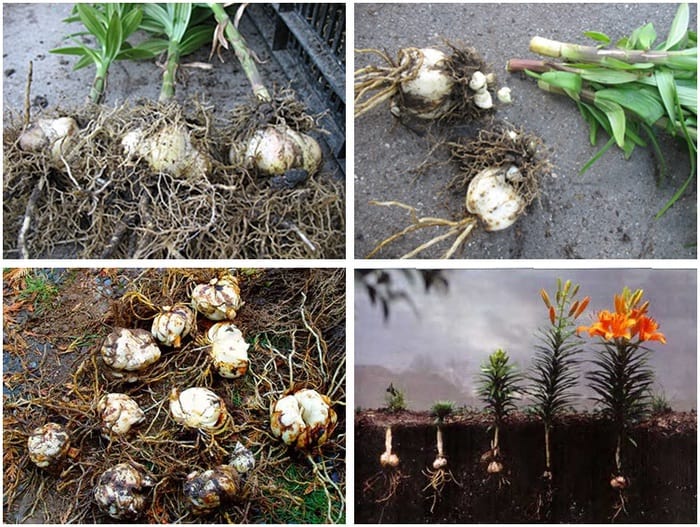

Lily transplant
Soil selection
The correct choice of soil for transplanting lilies is an important condition for their successful growth. Depending on the variety of plants, it is determined what kind of soil they need: acidic or alkaline.
Note! In any case, the soil for transplanting must be loose and permeable. Water stagnation is contraindicated for bulbous plants. It is necessary to prepare a nutrient soil with a neutral acid reaction. It should contain peat and sand.
Top dressing when transplanting
When planting lilies, double superphosphate and potassium sulfate are added to the soil. Lime or dolomite flour is added to acidic soil.
When to plant lilies outdoors
Thus, lilies are suitable plants for the garden. They are undemanding to temperature extremes, relatively resistant to diseases and pests.
Since the full growth of plants depends on the condition of the bulb, they must be fertilized. When planting, at the stage of budding and flowering, different feeding is required. You need to pay attention to the season and the climatic zone. Top dressing is also important when transplanting plants to a new place. It is a prerequisite for the full growth and development of lilies.
The result of flowering will also depend on the quality of plant care throughout the year.
What to cut off a lily so that it doesn't smell
Pruning is practiced not only after flowering, but also during it. These flowers are well known for their pungent and strong aroma, which is produced by the release of special volatile oils from all organs of the plant. However, this smell is not always pleasant for humans, and in some cases it can cause allergic reactions.
What to do if the bouquet is beautiful and the smell is too heavy for you? In this case, it is recommended to remove the stamens of flowers, because it is on them that the smelling pollen is collected. To do this, you need to bring a paper bag to the bud and carefully cut the stamens into it. When doing this, use gloves to prevent pollen from getting on your fingers. This procedure should be repeated with each blooming flower.
The author of the video will tell you how to get rid of the smell of these flowers.
Lily storage
Bulbs intended for spring planting are stored. Dried and prepared planting material is rolled in ash and placed in wooden boxes or other suitable containers. Cover the top with a layer of sawdust or moss. This is done so that the bulbs do not dry out.


Containers with prepared planting material are placed in a dry, basement or other cool room. The onions do not require careful maintenance, you just need to periodically slightly moisten the top layer of sawdust or moss. You should not be too zealous, as the bulbs can rot. The room should also be ventilated periodically.
How to dig it right?
In order to carry out the procedure efficiently and painlessly, you must adhere to simple rules.
Cropping flowers
You can and should start pruning only when the leaves turn yellow and dry completely.
At the end of the growing season, when the leaves have dried up, the plant is cut in such a way that a stem remains at least 6 cm long.


Unfortunately, it is impossible to name the exact date when this should be done, but based on practice, the period favorable for pruning and digging is at the end of September.
Digging out the head
Dig the onions very carefully so as not to deform them in the process. It is better to initially extract them with an earthen lump, which must later be carefully removed.
When the onion is removed from the ground and is in your hands, carefully examine it, if rot is present on it, it must be carefully cut off with a sharp knife. After that, the planting material is necessarily washed with water and disinfected.
For disinfection, you can prepare a weak solution of potassium permanganate, and leave the bulbs in it for 35-40 minutes. After water procedures, it is necessary to dry the bulbs.
In no case should you leave them in the sun, direct sunlight and open light in this case will only harm. Drying should be carried out in a sufficiently cool place where the temperature does not rise above 18 ° C.


Storage rules
Now the most important question: how to store the dug lilies in the winter at home. To do this, we proceed in order. After the bulbs are dry, it is advisable to roll them in ash, and then place them in a cardboard box, a plastic container with a lid, or a paper bag.
This is to protect them from light. In order to create a favorable microclimate in the package, you can add sawdust or moss there.
When the bulbs are dried and wrapped, they are stored in a cool, dark place; a basement or refrigerator is ideal for this.
Wintering lilies in the open field
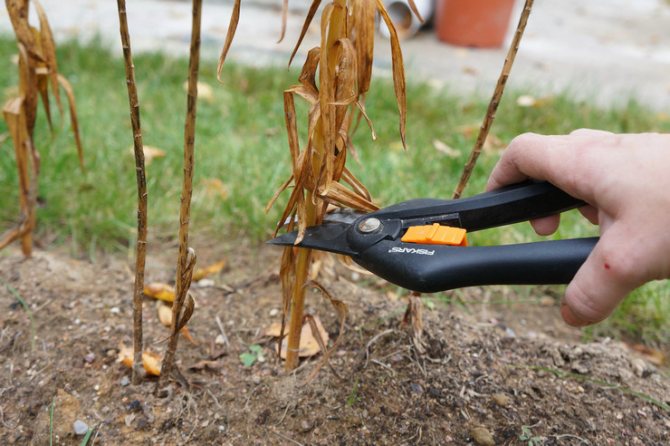

Oriental lilies
Eastern hybrids do not like excessive waterlogging of the soil. That is why flower growers recommend that lilies of these varieties be dug out before heavy autumn rains and not planted on open beds until the snow melts. From an excess of moisture in the soil, the bulbs will gradually begin to rot.
If storage of planting material at home is impossible, then it is worth using the method of wintering lilies in the open air. True, you need to take care of future storage in advance, even during planting. For this, raised flower beds are built, on which planting holes are dug and filled with a drainage layer of river sand.
Oriental lilies are perfectly preserved in winter under a cover of spruce branches or compost and polyethylene. It is very important to cover the plants before the onset of long rains, but after their aboveground part wilts. With the arrival of spring, the spruce branches and the film are removed, and the compost is left as an organic fertilizer.
Asiatic lilies
Lilies of Asian hybrid varieties are not afraid of even the most severe frosts, but the presence of a snow cover is required. In the absence of snow, you will need a "blanket" of compost or peat, as well as of plastic wrap. Unlike oriental hybrids, these lilies need to be insulated only when the first frost appears and the soil freezes slightly. But it will be possible to remove the cover after the snow has completely melted.
If all the requirements for organizing the storage of bulbs in summer are fulfilled, lilies will reward flower growers with lush flowering and a unique pleasant aroma. The main thing is to make every effort, patience and attention.
How to preserve lily bulbs that are not suitable for wintering
So, the varieties and varieties of lilies that do not like the Russian winter too much will need to be dug up in the fall. Digging up the bulbs and preparing them for storage is carried out as follows:
- cut off dead stems from the lily;
- dig the nests;
- shaking off the ground, carefully examine the bulbs - dry scales, damaged and rotten roots must be removed immediately;
- rinse the lily bulbs under running water;
- soak them for half an hour in a solution of karbofos or foundationol (you can use potassium permanganate);
- Dry well in the shade after soaking.
If you do not plan to plant lilies in the fall, then you need to place the bulbs for winter storage. Another question is how to preserve lily bulbs in winter? There is nothing difficult in this - carefully place them in a container and cover them with wet moss or burlap on top. Store the planting material in a dry room before planting in spring, and cut the roots to 5 cm before planting.
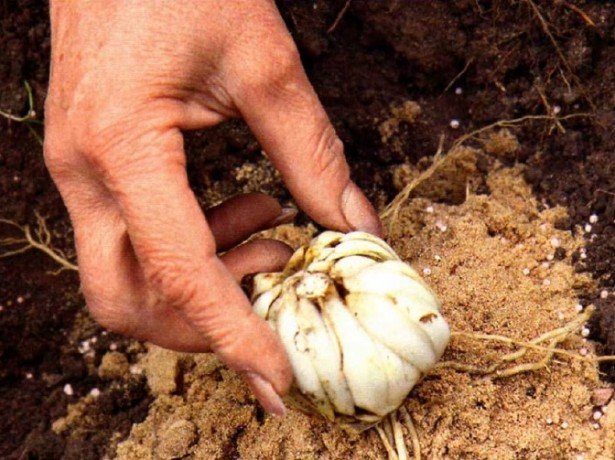

If you are not planning an autumn planting of lilies, then you need to place the bulbs for winter storage.
Fertilizing a flower during planting or transplanting
Planting young, as well as transplanting old plants is best in August, but you can also in spring. The area intended for lilies must be dug up to a depth of 40 cm.
Heavy soils should be "diluted" with sand and peat (1 bucket each for 1 sq. M. Beds). To recharge the poor soil, add:
- from 5 to 10 kg of rotted manure (depending on the degree of soil depletion):
- 50 g of potassium sulfate;
- 100 g superphosphate.
These fertilizers are quite enough for Asian hybrids, but tubular lilies additionally require the addition of ash (up to 500 g per 1 sq. M.).
As for oriental hybrids, it is first necessary to lay a drainage layer in the planting pit, and only then fill it with a mixture of humus, peat and turf (in equal proportions). Lastly, spill everything with a saturated color potassium permanganate solution.
After fertilizing, mix them with the ground and water the well well.
After planting lilies, mulch the ground around to prevent rapid evaporation of moisture. Scatter the chopped bark of coniferous plants throughout the flowerbed (or around the plants). Fallen needles can also be used.
On average, every two to three years, lilies are recommended to be transplanted, since they are capable of forming many children, which take away the strength necessary for flowering from the mother's bulb. As a result, the peduncles become smaller and smaller, and the flowers themselves become smaller several times.
Dig or hide?
To choose the right wintering option, two factors must be taken into account:
- a kind of lily;
- climatic features of the region.
Frost-resistant species include:
The bulbs of these varieties can be safely left in the ground, covering them for the winter.
They require more thorough preparation in the fall. The plant bulbs are dug up and kept in a warm room. An excellent option would be to transplant lilies into a greenhouse.
Excavation is a necessary measure in the case of hybrid varieties, when it is necessary to remove the babies that are tightly attached to the mother bulb. Ignoring this procedure will negatively affect the condition of the plant, because the children will take all the nutrients and moisture.
In the Moscow region, in the middle lane, where winters are relatively mild, frost-resistant lilies do not need to be insulated. If we are talking about the Far North and regions similar in climatic features, the question of how to prepare lilies for winter remains relevant.
Shelter options for flowers
If the plant variety is frost-resistant, overwintering the bulbs in the ground is a good option. But you still need to take care of additional insulation. To prepare a winter shelter, you need to choose materials. They are divided into natural and artificial.
Natural include:
- pine branches, from which spruce branches are formed;
- humus;
- sawdust.
Among the artificial ones there are:
For regions with a temperate continental climate, organic insulation will be a suitable option. Lily bulbs are covered with a thick layer of material - this will protect them from low temperatures, wind and precipitation. In regions with a contrasting climate, lilies are covered with a layer of organic and then artificial insulation. This is quite enough to protect plants from frost and temperature extremes.
Read also: How to use the covering material "Agrotex"
The shelter is removed when the weather is stable.
When to prune lilies
Many amateur gardeners do not know when to remove lilies, so they completely cut off their stems immediately after flowering, that is, as soon as the petals fall off. They do not even suspect that they are causing irreparable harm to their favorites.
After flowering in the stems and leaves, the process of photosynthesis continues. Nutrients continue to flow through both the roots and the terrestrial parts of the plant.With premature pruning of the stems, the bulb will no longer receive some of the nutrients. As a result, a slowdown in its growth may be observed, up to a complete stop. Thus, the bulb may not grow to the size required for successful flower stalks the following year.
In the first year after planting, lilies have a small bulb. For those who want the young lily to gain strength and delight the grower with luxurious large flowers for the next season, it is advisable to cut off all the buds. In this case, she will receive more nutrients that are so necessary for her in the first year of life.
Important! If it is necessary to collect lily seeds, the peduncles are not cut off.
In subsequent years, the bulb will already be acclimatized to soil conditions and there will be no need to cut the buds during flowering. When to cut the flower stalks of a lily in this case? After flowering, the petals gradually fall off on their own and only the seed capsule remains on the stem. Then it is necessary to cut off the peduncle. This trim is required. If you do not remove the seed capsule, all incoming nutrients will go to the development of the seeds, and not to the development of the bulb. It will also negatively affect future flowering.
Pruning lilies into a bouquet
Lily bouquets look luxurious and sophisticated. Is it possible to cut flowering lilies into a bouquet without harming the bulb? Naturally, yes, but for this you need to pay attention to some nuances:
- For bouquets, you should choose flowers that have 5 or more buds. This is a sign that the bulb has already reached a sufficient size for further development.
- When cutting lilies, it is necessary to ensure that the stem remains at least 20 cm high from the ground.Thus, the supply of nutrients to the bulb will not stop.
Pruning lilies into a bouquet
- The cut should be done at a slight angle with a sharp pruner. This will prevent rainwater from getting inside the stem and the bulb will not rot.
- The cut site must be treated with wood ash for quick healing. This will help to avoid stem rot, as well as disease of the entire plant.
High odor pruning
Lilies have a specific, pungent aroma. Not everyone likes this smell. Especially it is not to the liking of people prone to allergies. Do I need to cut the lilies during flowering in this case? After all, the deadline for cutting the buds has not yet come, and it is a pity to remove the flowers at the very beginning of flowering.
The lily scent is formed from the volatile oils released by all the terrestrial parts of the plant. The biggest source of odor is the pollen that accumulates on the stamen. Removing it, not the entire stem, will help weaken the scent. To do this, you need to bring a paper bag to the bud and carefully cut off the stamens from it. This procedure should be repeated with each blooming flower.
Important! Lily pollen is poisonous to humans and animals, especially cats. Therefore, care must be taken. Wear gloves to prevent pollen from getting on your fingers. People with allergies should wear masks.
After removing the stamen, the lily scent will remain, but it will be subtle and unobtrusive.
Pruning stems and leaves
Plants should be inspected as often as possible for diseased or damaged tops. If found, they must be removed, regardless of the stage of development. You cannot completely cut off all the tops; you should leave as many green and healthy leaves as possible.
Pruning stems and leaves
In some cases, you will have to completely remove the plant:
- If the foliage is covered with specks (spots). This means that the lily got sick with mosaic - a viral disease.
- If the bulb or roots are rotten.
Pruning rules
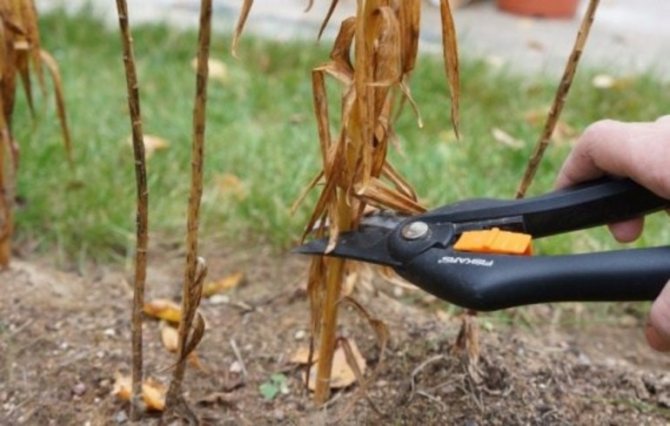

First, it is enough to remove the wilted flowers, and then gradually shorten the peduncle, but this should be done when the lilies have faded and the stem begins to dry out on its own. It is recommended to completely cut the peduncles only after they are completely dry.This happens in late August - early September.
Then you can already take up the scissors without fear of harming the onions. After pruning, no more than 15 cm should remain from the stem. The cut is made along an oblique line so that moisture flows down during rain. House lilies growing in pots are pruned in the same way.
If the goal is to obtain planting material, then the flowers are left and wait for the seeds to ripen.

